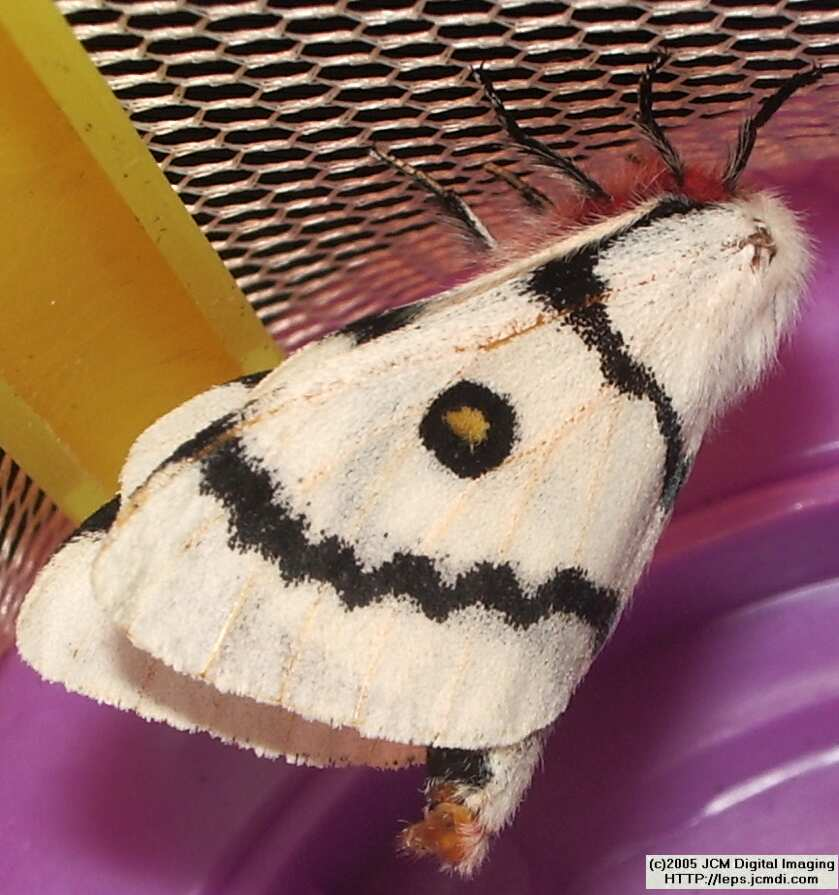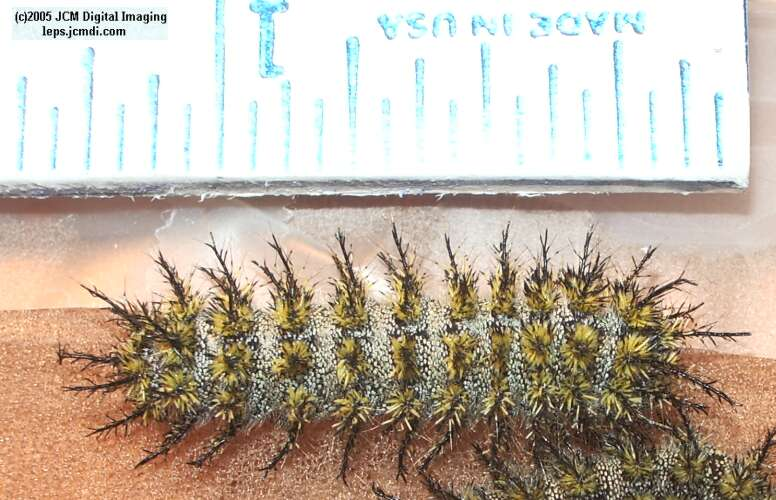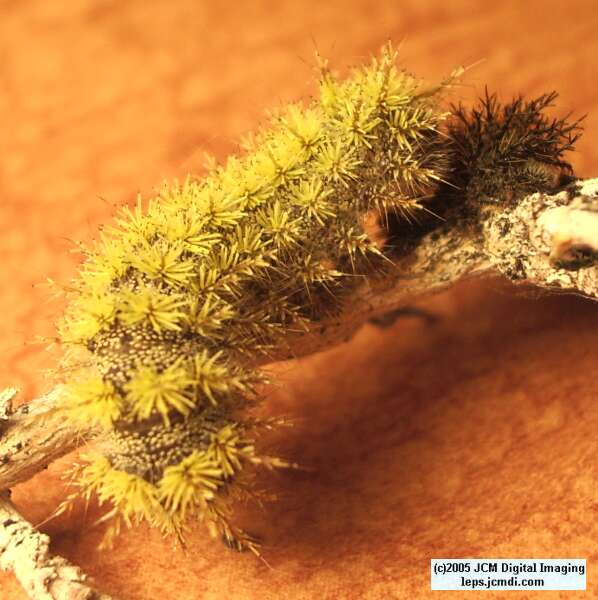Skipping over Hemileuca boisduvali, quickly shown to be the same thing as H. eglanterina, and H. bifasciata, quickly shown to be the same thing as H. burnsi, we come to burnsi itself. Burns' Buck Moth is one of the six, out of more than sixty, kinds of Hemileuca whose DNA is distinctive enough to keep them classified as a distinct species. Google has lots of material about this species, because it's pretty, as moths go, anyway, and it lives in California.
(Butterfly photographers usually want and deserve credit. Moth photos pop up in different places, making it hard to tell who deserves credit; since some people don't like to look at moths, some might even say the photographers deserve blame. Some pictures here come from fantastically detailed photo essays that have been linked and credited; others, like this one, seem to have been donated to science.)
Some Hemileucas are garishly colored but burnsi display a very simple, yet striking, color pattern.
The "buck moths" are, as we saw with H. artemis, a genus of madly variable moths. They're thought to have originated in the dry west-to-central part of North America, because their behavior seems adapted to dry air, hot days, and chilly nights. Variations in diet, weather, and individual DNA can cause moths that hatched from the same egg cluster to look as if they belonged to different species.
Burnsi has been given other names, some at first accepted as different species names. It's bifasciata because most individuals have two narrow bands of black across the white forewings, nigrovenosa because the black bands suggest veins, and paradoxa because it may or may not be able to crossbreed with the "sibling species" H. electra, which is active in some of the same times and places, but in recent years entomologists have agreed that its most noteworthy feature is having been named after somebody called Burns.
For "giant" silk moths they're small, especially when they fold up their wings, as they often do, and try to pass for oversized Noctuids. Hemileucas aren't very big. The unfolded wings may spread out to all of two inches, or more or less.
For some of these moths it's possible to say that the hatchlings all start out looking alike but, by the fourth or fifth instar (and they can molt through seven instars, growing bigger, more venomous, and harder to whack with a stick in each new skin!), siblings can look different. When we get to the E's I'll try to include a fair-use photo documenting that hatchlings, as they crawl out of eggshells laid in one clump, can look like three different kinds of first-instar caterpillars. (That means they can look like their father, their mother, or a grandparent--all in one litter produced immediately after a freshly fledged female moth mated just one time. Something interesting is going on with their DNA.) That's one reason why Hemileucas cause entomologists to tear out their hair and swear in possibly novel mixes of languages.
The other reason is that, while Hemileuca caterpillars can be any color including plaid (yes, literally, plaid), what they all have in common is that they're covered in little branching spines. While many other caterpillars have branching bristles that are harmless, mere mimics of Hemileuca's bristles, each of these caterpillars' bristles contains about as much venom as a bee sting. An entomologist in Florida has produced a video documenting that how many bristls touch yoour skin makes a big difference.They share with a few "related" genera, Autometis and Saturnia, the nickname "stingingworms."
There are people who would miss the Hemileucas if they went extinct, but having lived through their local extinction, recovery, and re-extinction, I'd predict thsat those people are in a minority. Nobody misses stingingworms. Nobody now has much hope that they're really gone forever this time--we've seen them come back, in quantities, before--but nobody ever wants to see another one. It is very hard to like an animal whose relatively weak grip and heavy weight, for a caterpillar, cause it to lose its grip and fall out of trees, stinging people who were just walking under the trees, doing the caterpillar no harm. So in 2001 the U.S.D.A. developed pheromone traps for some Hemileucas and determined that only about half the male moths thought to belong in the target species were attracted to pheromone traps. Given the urgency with which the silk moths seek mates, it was hard to say that this mean that many Hemileuca males in California are victims of crowded conditions (some sources document local populations having reached unhealthy density) or species confusion (individuals with otherwise different DNA looking alike), or even of moths being able to tell a difference between synthetic pheromone bait and the scent of a living moth.
It has, however, been possible for researchers to determine that female moths are not just sitting or flitting about, minding their own business, when all these males approached and began displaying themselves. Female moths actively, though silently, "call" for mates by assuming a specific posture in which a scent gland can be extruded, often rhythmically, releasing bursts of scent. This is why female Hemileucas usually choose a mate immediately after the process of spreading their wings is complete, sometimes before. Silk moths have short adult lives; it's to the female's advantage to start placing her eggs as soon as she can start flying. While flying, she stops summoning males, so they move on and compete for another female's attention.
The model here was raised from a caterpillar in California. A complete photo essay of her life, including pupation and eclosion, is available at http://lepidoptera.jcmdi.com/m/Sat/burnsi/burnsir.html . Hidden in the little tuft of brown hair on her tail segment, the female moth above is flicking her scent gland in and out, actively exuding waves of a chemical other moths can smell. This behavior is known as "calling" or "scenting." Humans neither hear the call nor smell the scent, but moths do--they seem to see, hear, and smell different ranges of stimuli than we do. The female silk moth has only a few days to lay her eggs and needs to get them fertilized. She has no time for subtleties. To other moths she's screaming "Take me now!" though Hemileucas don't actually grab; if several males show up she'll choose one, the others will rush off in search of other females, and she and the chosen male will snuggle.
What does she smell like, to the moths who can smell her from a distance? It's hard to imagine. Her scent contains palmityl acetate, a "fresh, sweet" smelling ingredient found in some skin lotions, but since users of these skin lotions aren't mobbed by male moths we have to imagine that other chemicals provide the dominant notes of her fragrance.
In some cases male Hemileucas are attracted only to their own species, or sub-species, or type, but this may not always be the case. In California research showed that some nuttalli males were atttracted to eglanterina females, and some were not. The moths in the same area looked similar, but females pheromone-"called" for mates with slightly different odors at different times of day (Hemileuca fly in the daytime.) Some individuals in these species, or sub-species, hybridize readily, and some do not. H. burnsi and H. electra do not hybridize well. Male burnsi are sometimes attracted to one sub-speces of electra, but not to another. A researcher "forced" some male H. burnsi to hybridize with female H. electra mojavensis and found that, in fact, these two species did not produce viable hybrid offspring
Once the calling female has attracted and accepted a mate, the couple slow down and enjoy being together for an hour or two. In nature Hemileucas typically cling to a twig so they can mate face to face, but their flexible bodies can mate side to side while they cling to the screen of a cage. The female then spends ten to twenty minutes flying while the process of fertilization completes, then drops eggs in a cluster on a twig of something her young will be able to eat. Then she finds another twig and lays another cluster of eggs. Typically female Hemileucas produce three egg clusters, the biggest one first, before their bodies' energy reserves run out. Meanwhile, a male may be able to mate with three females in his lifetime. Like all the big silk moths they don't eat or drink, but live entirely on the energy reserves stored as fat in their bodies, which last only a few days.
Her legs and underside were red when she was a caterpillar (many stingingworms' undersides are reddish) and the underside of her thoracic segment stays red while she's a moth. Burnsi don't necessarily arrange their egg clusters in a ring shape, as their neighbors, H. electra, usually do.
When the eggs hatch, the baby caterpillars are likely to stay in a cluster, as much as possible, for their first week or so of life. Although they are cold-blooded they can use this clustering behavior, as well as their thick dark skins, to regulate their body temperature through hot afternoons and chilly nights. The cluster is also less attractive to most predators than an isolated caterpillar would be...and since the babies already have some venom in their little spines, touching the cluster will discourage any predator desperate enough to try it.
An important adaptation to life in Southern California is the ability to eat whatever is able to grow in a given year. Burnsi caterpillars can eat several kinds of leaves, including almond and fruit trees as well as many garden flowers. The Calscape gardening site lists more than a dozen flowers that are native to California and may attract Hemileuca burnsi.
This particular brood was then adopted by humans and kept in a cage. People who've tried it say that Hemileucas are hard to rear, and although these caterpillars' human godparents successfully reared a few viable adult moths, most of the caterpillars failed to pupate and mature normally. Most did, however, survive as caterpillars. By the third instar they're showing more color variation--at least shades of gray--but still living in a cluster. At night they can huddle together to conserve warm air.
By the fourth instar, the black skin is almost covered in white dots, and the black central spines of the bristles are surrounded by yellow branches. Each tip is a "stinger." The more tips touch your skin, the more venom. Thus the caterpillar punishes those who grab or crush it more severely than it does those who merely get in its way, as it might be when the fat, foolish little beast falls out of a tree.
The bristles change with the skins. This little fellow, just entering the fifth instar, is standing on its discarded gray-brown skin in its new coat--California gold!
From below, this individual's feet and underside are a much paler shade of red-brown than its head. The brood studied at the JCM site all seemed to be in the same general color range, showing more consistency than some Hemileuca family groups show. They can look different, though they're not as variable as some Hemileucas. There can be a white stripe along each lower side...
,,,or dark stripes crosswise, or both (this is one of the species in which some individuals can fairly be described as plaid).
An extensive collection of H. burnsi photos is available at https://www.inaturalist.org/taxa/221168-Hemileuca-burnsi/browse_photos .
During pupation the caterpillars don't really dig down into the ground as some Sphingids do, and don't spin cocoons. They just curl up as deep under the loose layer of leaf material, sand, gravel, etc., as they can easily get, all their bristles out, and wait. It can take several days for the larval skin, with its bristles, to loosen, leaving a pupa much smaller than the caterpillar was, helpless, on the ground. Looking like a pebble or bird dropping is its only defense. In 1974 Smith reported that cage-reared caterpillars could pupate successfully in a box of Kitty Litter with shredded tissue paper on top. This kind of dry, absorbent, initially sterile material seems likely to have helped, but nature seems to stack the odds against all the big silk moths. They are just too big and hungry to be allowed to reproduce as freely as smaller moths do.
In Texas, the typical burnsi caterpillar can be mimicked by Hemileuca grotei. The resemblance is probably produced by biochemicals in the plants it eats, since grotei is "grotty" enough in its own right and does not need to impersonate its cousins to look nasty...or be nasty. All photos ganked in this series will appear at the page for the correct species, but you might want to visit http://sherylsmithrodgers.blogspot.com/2012/04/caterpillar-id-request.html for comparison. (Grotei moths have the same general wing pattern as burnsi but most of grotei's wings are gray or even brown, rather than white,)
Paul M. Tuskes, whose Wild Silk Moths of North America now lumps all the Hemileucas into just six true species with lots of variation, took his turn trying to define the differences between the named species on the Pacific Coast so that it would be possible at least for entomologists to tell them apart by looking. But that was before DNA studies...Yes, the "image" here is a PDF document.
In 2017 Rubinoff, San Jose, and Peigler discussed the possibility that environment has more to do with these moths' looks than DNA does. Instead of telling the moths' bodies to show a certain look, their genes may direct the bodies to develop a certain look in response to certain conditions.















No comments:
Post a Comment